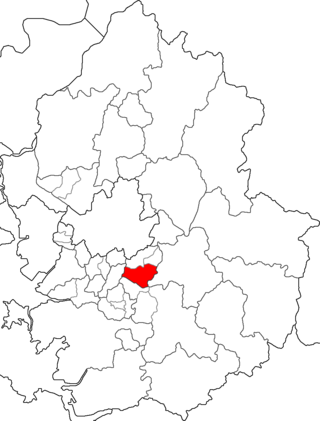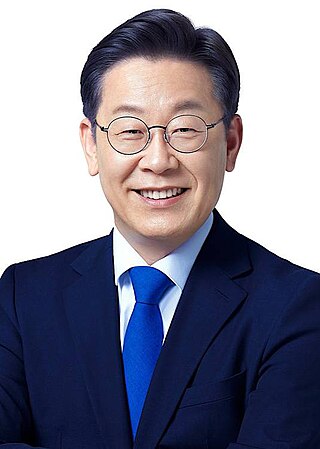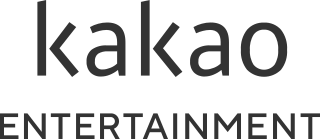
Gyeonggi Province is the most populous province in South Korea.

Yongin is a city in the Seoul Capital Area, the largest in Gyeonggi Province, South Korea. With a population over 1 million, the city has developed rapidly since the 21st century, recording the highest population growth of any city in the country. Yongin is home to Everland and Caribbean Bay, South Korea's most popular amusement and water parks. The city is also home to the Korean Folk Village, the largest of its kind. Yongin-si is a multi-nuclear city with multiple urban centers, not a single nuclear structure, and Giheung-gu crosses the Yeongdong Expressway and Dongbaek, while Suji-gu crosses Pungdeokcheon Stream and Jukjeon.

Seongnam is the fourth largest city in South Korea's Gyeonggi Province after Suwon and the 10th largest city in the country. Its population is approximately one million. Seongnam is a satellite city of Seoul. It is largely a residential city located immediately southeast of Seoul and belongs to the Seoul Capital Area.

The Shinbundang Line Korean: 신분당선; Hanja: 新盆唐線; literally, New Bundang Line) or DX Line for Dynamic Express Line is a 33.4 km (20.8 mi) long line of the Seoul Metropolitan Subway. It is the world's fifth subway to run completely driverless and the second completely driverless metro line to open in South Korea, after Busan Subway Line 4. It connects Sinsa station and Gwanggyo station in 42 minutes, a feat achieved by being the first line to operate South Korea's next-generation subway car travelling at over 90 km/h (56 mph), with the fastest average speed of any subway line in the country.

Bundang-gu (Korean: 분당구) is the largest and most populous district (gu) of Seongnam, a major city in the Seoul Capital Area, South Korea. Bundang-gu is one of South Korea's wealthiest and highest developed areas, being the nation's first and largest completely artificial city built in the early 1990s. Many high-rise luxury condos moved in the early 2000s, with a second planned city built in the late 2000s called Pangyo in the same district. Apartment prices are the second highest in Gyeonggi-do after Gwacheon and 7th highest nationwide, higher than many central Seoul districts such as Mapo-gu or Jongno-gu. Apartments around Pangyo station and the high-rise luxury condos around Jeongja station and Sunae station rival prices in the most expensive areas in the country. Unlike older cities such as Seoul, Bundang has no telephone poles overground, resulting in a clean cityscape with well-designed streets.
Hyundai Department Store (Korean: 현대백화점) is a major department store chain in South Korea. Its parent company is the Hyundai Department Store Group. It, Lotte Department Store, and Shinsegae are the three largest chains in the country.

The Capital Region First Ring Expressway (Formerly as Seoul Ring Expressway) (Expressway No.100) (Korean: 수도권제1순환고속도로; RR: Sudogwon Je1sunhwan Gosokdoro) is an expressway, circular beltway or ring road around Seoul, South Korea. It connects satellite cities around Seoul, Ilsan, Namyangju, Hanam, Pyeongchon, Jungdong, Bundang, Pangyo, Sanbon and Gimpo. The expressway runs 127.6 km. Seoul Ring Expressway is currently under construction to widen the expressway between Anhyeon Junction to Seongnam which is expected to be finished in 2016.

Pangyo or Pangyo New Town is a planned district composed of several dongs or neighborhoods of Seongnam, South Korea. It contains Pangyo-dong, Baekhyeon-dong, Unjung-dong, and Sampyeong-dong of Bundang-gu and Siheung-dong and Sasong-dong of Sujeong-gu.

The World Mission Society Church of God is a new religious movement established by Ahn Sahng-hong in South Korea in 1964. The church believes that Ahn Sahng-hong is the Second Coming of Jesus, and that Zahng Gil-jah is God the Mother. Ex-members and several experts have called it a cult. Its headquarters as well as its main church are located Sungnam City, Kyunggi Province, near Seoul.
Bulgoksan (Korean: 불곡산) is a mountain in Gyeonggi Province, South Korea. Its area extends over the cities of Seongnam and Gwangju. Bulgoksan has an elevation of 345 m (1,132 ft). The mountain shares a name with another mountain in the Gyeonggi Province near Yangju.

The Gyeonggang Line (경강선) is a rail line in South Korea, which at present comprises two distinct sections. The first one, which opened on September 24, 2016, is part of the Seoul Metropolitan Subway system in Gyeonggi Province, South Korea, and runs from the city of Seongnam to Yeoju City, partially coinciding with the route of the former narrow-gauge Suryeo Line. The second section, which is located entirely in Gangwon Province, runs between Gangneung and Wonju and opened on December 22, 2017, in anticipation of the 2018 Winter Olympics. This section of the line offers KTX service from Seoul, through the Jungang Line. In the future, the two sections are to be connected, and the Gyeonggang Line will be extended westwards to Siheung.

Pangyo Station (Korean: 판교역) is a station on the Shinbundang Line, serving the planned city of Pangyo in the city of Seongnam. The station is close to Pangyo Techno Valley, one of the country's largest clusters of software, gaming, entertainment and biotechnology businesses, home to major tech companies like Kakao. It began operations on October 28, 2011, with the opening of the Shinbundang Line.

Bundang (Korean: 분당) is a planned community in the Bundang-gu district of Seongnam, South Korea. It was developed to encourage affordable housing and urban decentralization. The community has a sports complex, a park and a youth center.

The Seoul Capital Area or Gyeonggi region, is the metropolitan area of Seoul, Incheon, and Gyeonggi Province, located in north-west South Korea. Its population of 26 million is ranked as the fourth largest metropolitan area in the world. Its area is about 12,685 km2 (4,898 sq mi). It forms the cultural, commercial, financial, industrial, and residential center of South Korea. The largest city is Seoul, with a population of approximately 10 million people, followed by Incheon, with 3 million inhabitants.
Pangyo Techno Valley Vents Collapse was an accident in Pangyo Techno Valley, South Korea on 17 October 2014, when spectators at a nearby concert fell to their deaths when a underground car park ventilation cover collapsed. Approximately 700 people were in the park to watch the band 4minute perform.

Lee Jae-myung is a South Korean politician serving as a member of the National Assembly and the leader of the Democratic Party of Korea. Lee was the nominee of the Democratic Party in the 2022 South Korean presidential election. He was the 35th Governor of Gyeonggi Province from 2018 to 2021.
Cha University is a private university in Pocheon and Pangyo, Seongnam, Gyeonggi-do, South Korea. It was founded on the basis of the three philosophies: Christianity, Humanism, and Academia.

Kakao Entertainment Corp., is a South Korean entertainment, mass media, and publishing company founded in 2021. A subsidiary of the Internet company Kakao, it was established subsequent to the merger of the latter's two subsidiaries KakaoPage and Kakao M.
The June 2022 South Korean by-elections for seven constituencies of the National Assembly were held in South Korea simultaneously with local elections on June 1, 2022.

Seongnam Bundang A is a constituency of the National Assembly of South Korea. The constituency consists of portions of Bundang District, Seongnam. As of 2022, 213,963 eligible voters were registered in the constituency. The constituency was created in 2000 from the Seongnam Bundang constituency.















